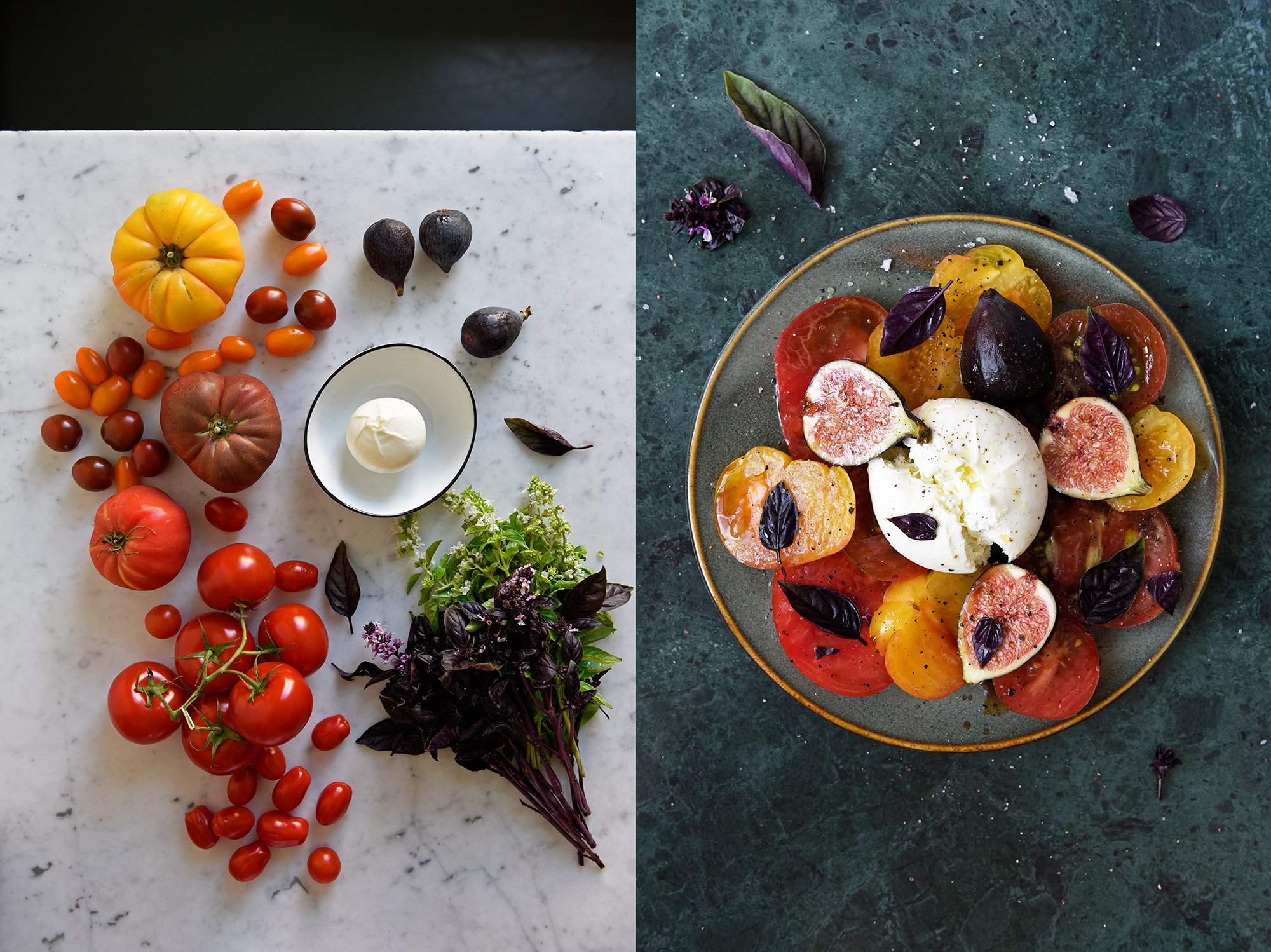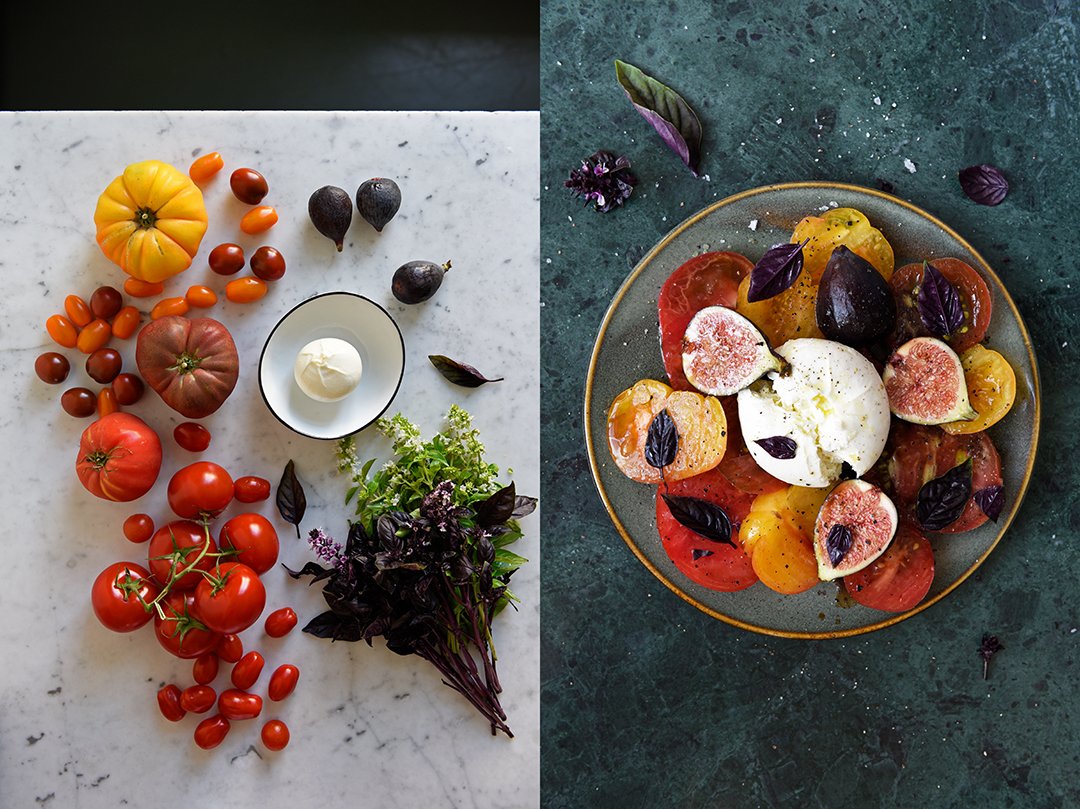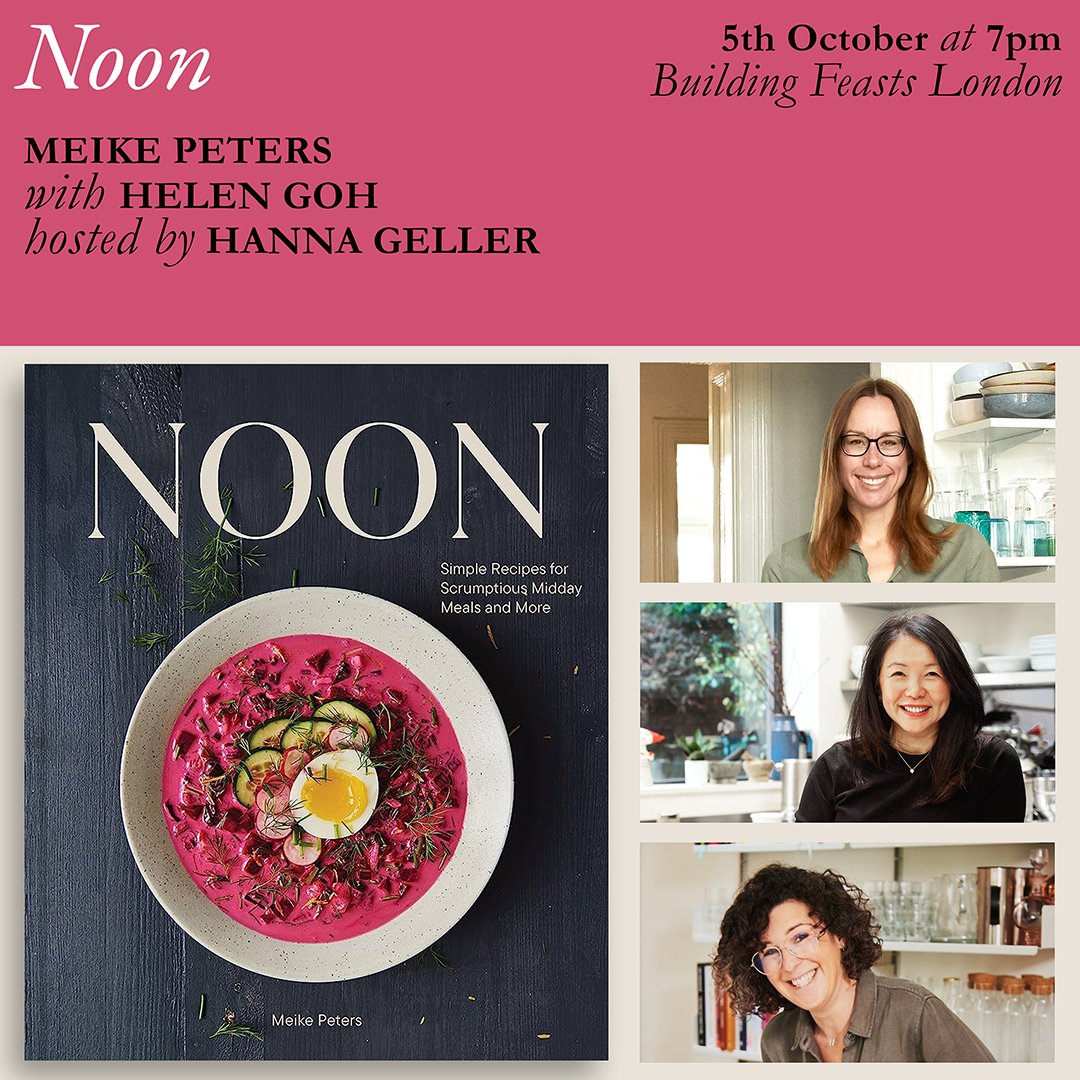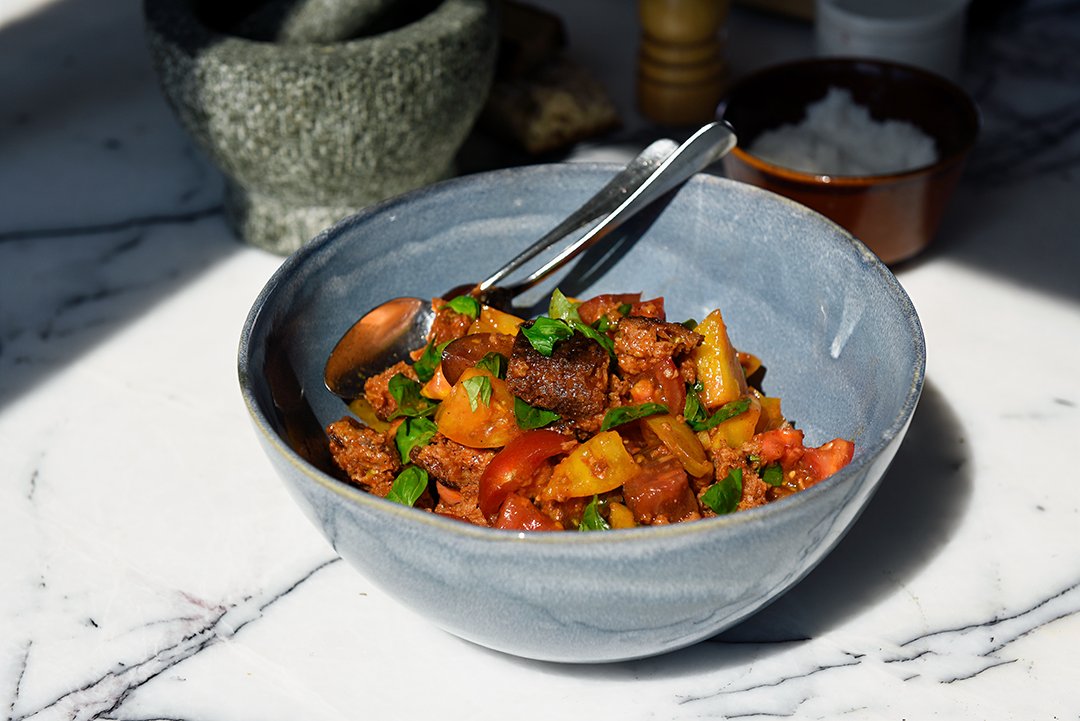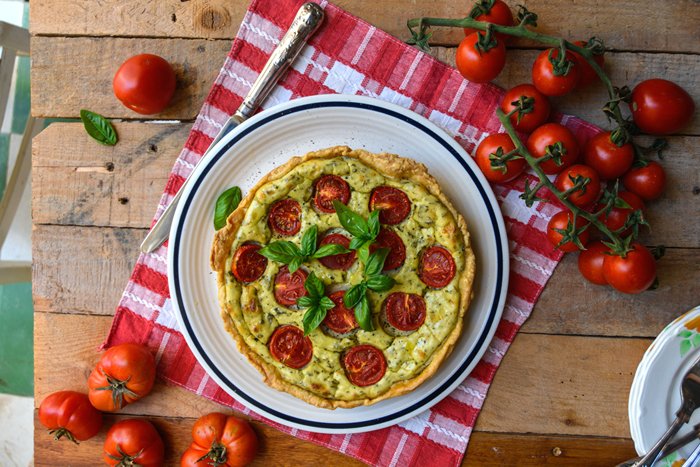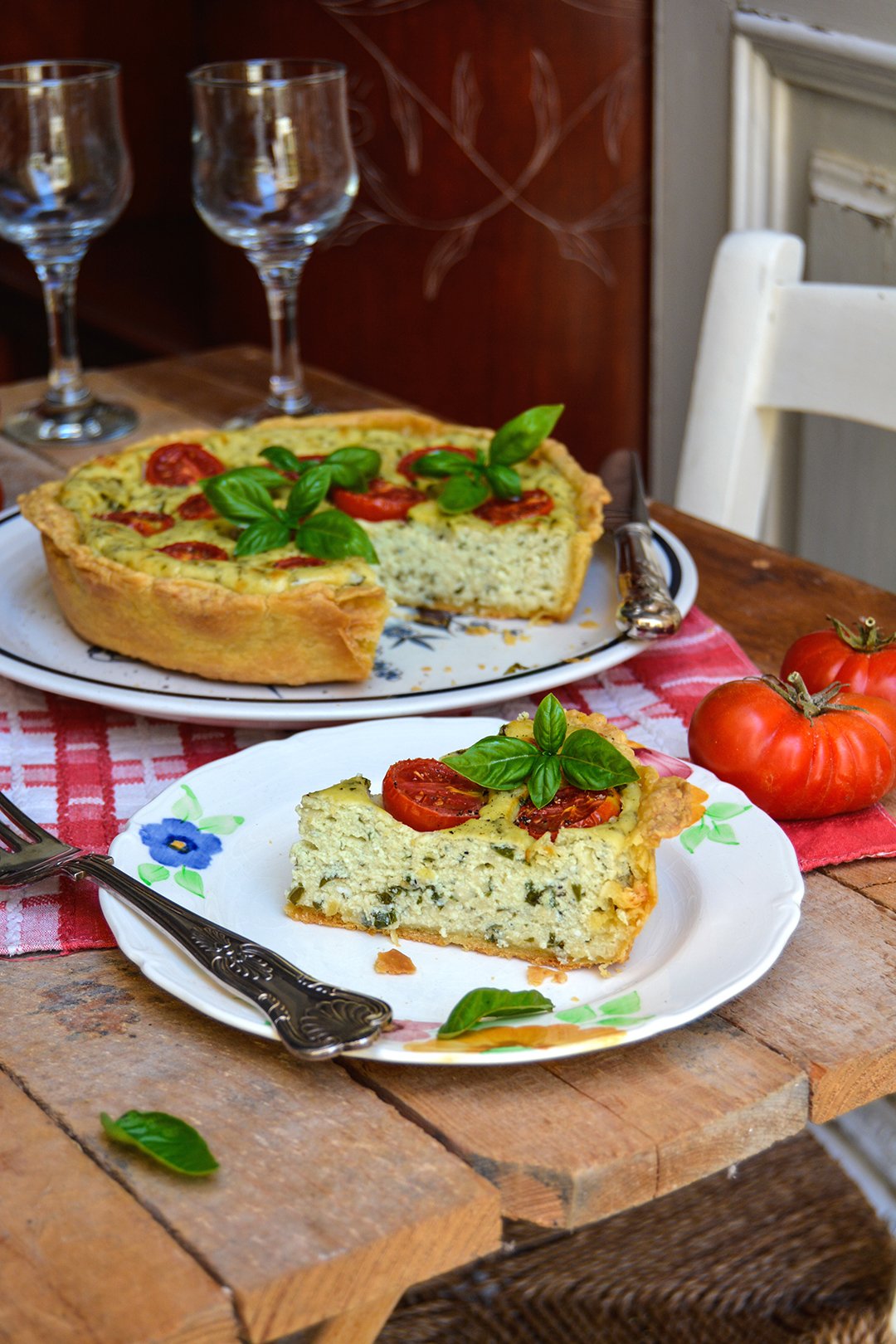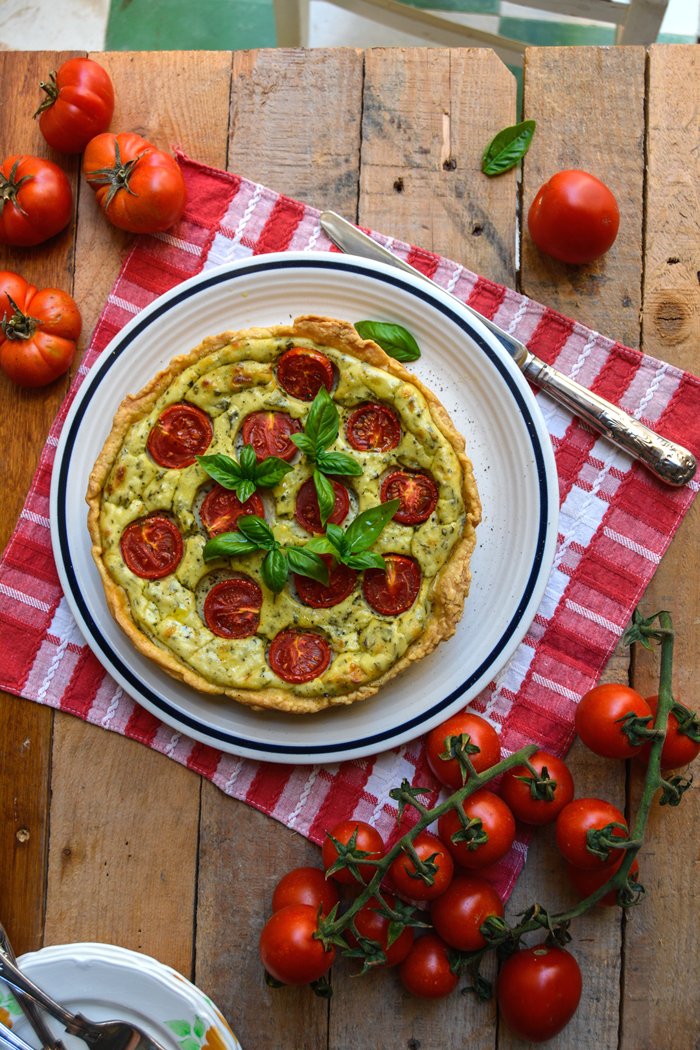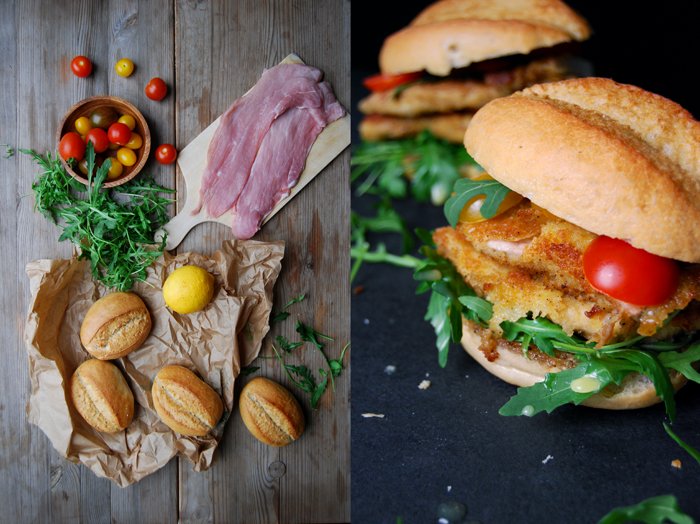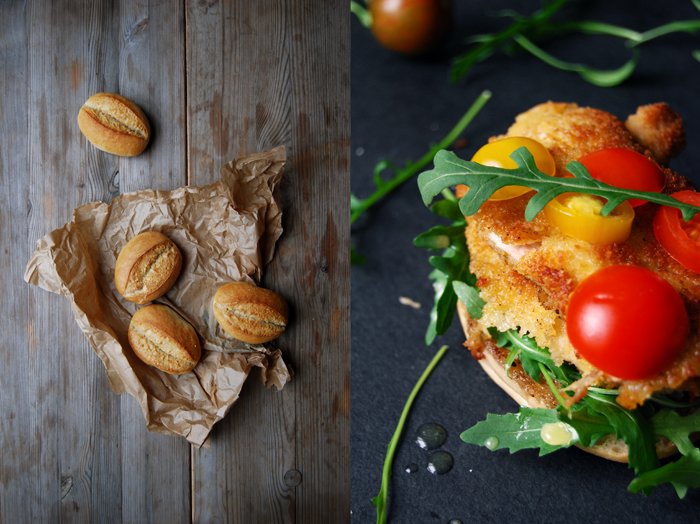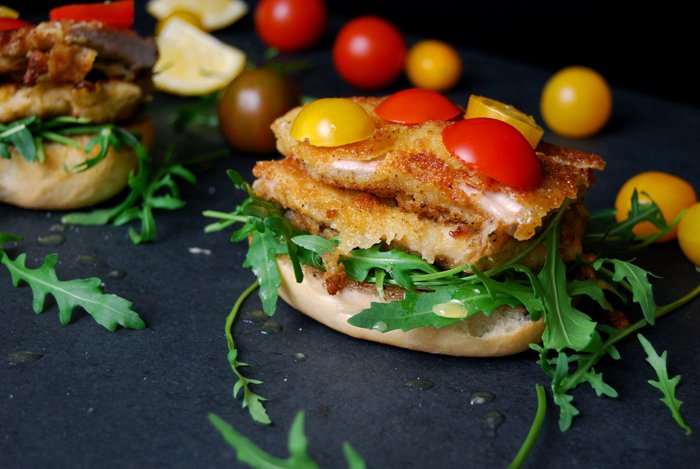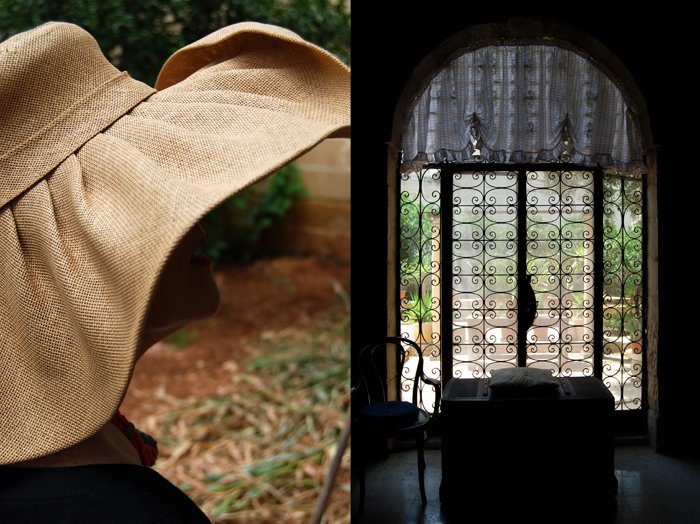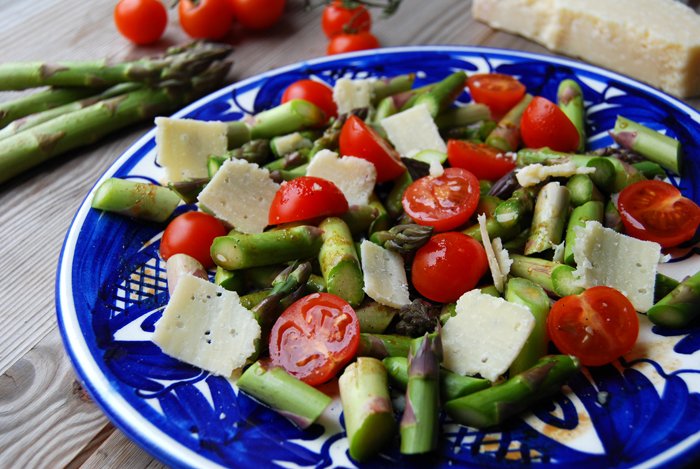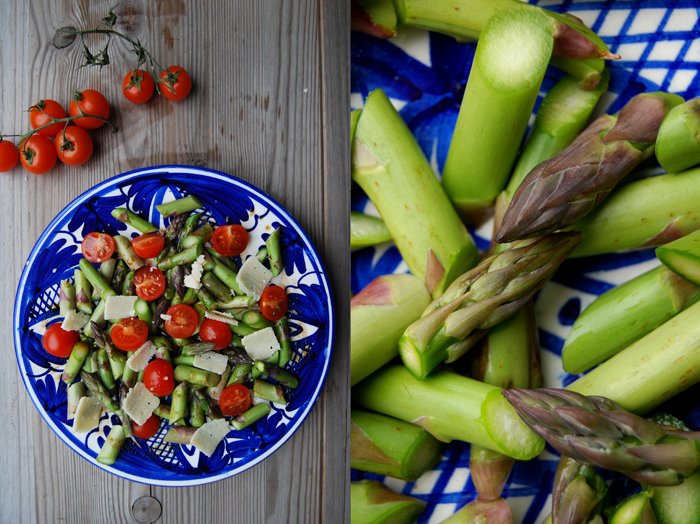Tomato and Fig Caprese & the NOON Book Tour
No other season inspires me as much as late summer. The mesmerizing abundance of vegetables and fruit in August and September never ceases to wake up my appetite and makes me want to experiment with it in my kitchen. Seeing the colorful fresh produce spread out at the stalls at the weekly farmers market in my neighborhood feels like a holiday for the eyes and the taste buds. Tomatoes in various shapes, colors, and sizes, yellow and green zucchini, bent and plump, apricots, peaches, and figs, and little berries that burst in your mouth when you pop their skins with your teeth. Red and black currants, gooseberries, and raspberries, pair them with a bunch of fresh herbs and a quick vinaigrette and you have an exciting salad ready for lunch in less than five minutes.
The classic caprese, loved and adored every summer all over the world, is kind of the mother of all simple salads. You just need juicy tomatoes, creamy burrata (or stracciatella), torn basil leaves, olive oil, balsamic vinegar, sea salt, and pepper. Replacing the usual mozzarella with burrata or stracciatella, using olive oil that’s so good that you want to lick it off your fingers, and my sea salt from Gozo, are game changers in a simple caprese. One of the most important kitchen rules is so true: the less ingredients you use, the more you have to focus on the quality of each single one of them.
A good caprese is built on ripe tomatoes, picked at their peak, and that’s the tricky part. Even in August, even the prettiest tomatoes from your trusted farmer at the market can sometimes disappoint. And if they taste bland, they won’t make your dish shine either. To avoid this, I’ve come up with various experimental caprese recipes over the years, moving away from tradition and using all sorts of fruits and roots throughout the seasons; summer’s bounty of peaches, berries, and plums, or beet, persimmon, and orange in winter.
Until now, I always refused to pair tomato with another fruit, the combinations never really satisfied me. So at first, I was hesitant when I spotted purple figs lying on my kitchen counter and considered adding them to a classic caprese. But: the result was fantastic! The figs add concentrated sweetness without distracting from the tomato’s own qualities. They just make them taste a bit sweeter, somehow, they make them taste like very ripe summer tomatoes.
It’s a kitchen hack, kind of, that I wish I had figured out before I wrote my new book, NOON. Now the book is printed so I guess I have to use this hack for the next one. But before I jump into new adventures again, I’m ready to fully enjoy seeing NOON enter the world. On September 5th (September 19th for the German book), NOON will be on the shelves of bookstores all over the world (and on sale online) - and I will go on a little NOON book tour: New York, Berlin, and London!
Before I’ll let you enjoy your tomato and fig caprese (recipe below), I’m sharing the tour dates with you and the wonderful people who I’ll be in conversations with - and a quote from an (early) starred review for NOON:
“Move over, breakfast: lunch is about to become the most important meal of the day.”
―Library Journal
If you don’t want to wait until September, you can pre-order NOON here, or support local and pre-order from your neighborhood bookstore.
NOON BOOK TOUR
NEW YORK
• September 7th, 2023, 6pm: at Rizzoli Bookstore, with Hetty Lui McKinnon, RSVP here (not required, but seating is limited and will be first come, first served)
BERLIN
• September 19th, 2023: in conversation with Billy Wagner of Nobelhart & Schmutzig (by invitation only)
LONDON
• October 5th, 2023, 7pm: at Building Feasts, with Helen Goh, hosted by Hanna Geller, ticketed event (to book a ticket, click here or email Hanna at info@buildingfeasts.com)
Thank you, Lallier Champagne, for sponsoring the NOON Book Tour!
Tomato and Fig Caprese
Serves 1
3 medium, very ripe tomatoes (preferably in various colors), sliced
2 figs, cut in half lengthwise
4 ounces / 110g burratta (or stracciatella or mozzarella di bufala)
olive oil
balsamic vinegar
flaky sea salt
ground pepper
a small handful of red or green basil leaves
Spread the tomatoes on a large plate and arrange the figs and burrata on top. Drizzle with a little olive oil and vinegar, season with a little salt and pepper, and sprinkle with basil. Enjoy immediataley!
Meet In Your Kitchen | Moritz, Switzerland & the Grill Royal Family
This post is part of my Meet in My Kitchen podcast: How did we get to where we are in life & what does food have to do with it
"Food is probably the most important thing for me besides breathing. But I guess sex is also pretty important." - Moritz Estermann
When you grow up in the Swiss Prealps and you find your peace with the fact that you live in a tiny village only surrounded by nature, then Switzerland is the best place to live in. However, if at one point you want to know what there is on the other side of the mountains, you have a problem. Then you have to leave.
Moritz Estermann liked his life, tightly woven into a safe net of family, friends, and Swiss food. During the week he would play in the neighbors' fields and barns, the weekends would be all about walks in the mountains together with his parents and brother. And when he could tell his father the names of 20 flowers he would get French Fries in one of the mountain huts. Moritz doesn't want to make it sound like Sound of Music - but it does.
But one day, the Swiss fairy tale ended and Moritz left the mountains behind to move to Berlin. And as he arrived, walking down Strasse der Pariser Kommune lined with its very vertical, very unadorned socialist buildings, he felt home and ready for a new chapter.
"We started at Pauly Bar, moved on to the Grill (Royal) then we went to King Size Bar at 1 at night and left at 6 in the morning, staggering. But I had to be back in the office at 9:30, often working on bookkeeping. It was an absolutely amazing time, I learnt everything this business is about, but you shouldn’t do this. You get bogged down. It’s too much. Your own life falls by the wayside. Completely." - Moritz Estermann
Grill Royal, Kin Dee, Bar Freundschaft, Dottir - Moritz Estermann's name appears behind many raisins in Berlin's gastronomic cake but the man himself stayed a mystery for me for a long time. I had been wanting to meet him for years and it had to happen during a long and tipsy night out at Bar Freundschaft. Introduced by Susan Choi, and soon rebuked by Moritz as I told the sommelier "I'm sure you don't have pastis," the first sentence Moritz ever said to me was: "Don't be so negative!." I felt like a little girl, but he was right, and I got my drink in the end.
So how does a Swiss boy end up in the 'Grill Royal family' at quite a young age? He's not only supervising some of the 'family's' places, but he's also Stephan Landwehr's and Boris Radczun's - the founding fathers - copartner in a few endeavors. How does he start new projects and each and every single one is a success? The answer is very Swiss: Moritz says he understands restaurants and he understands Berlin.
But there's more behind this humble Swiss mind. Moritz has a great connection to his instinct and he completely trusts this instinct. I've seen this talent in the characters of all the people I'm talking to for the Meet in My Kitchen podcast. They can all hear their inner voice and learnt to always listen to it. Moritz instinctively goes to the right places, connects with the right people, feels the inspiration, and then picks up the right projects. It's not luck, his success rate is too good for that. It's a very clear focus on what makes sense and then hard work and discipline to get there.
What I love about people in the gastronomic world is that despite this discipline, they never miss the party. What I love about Moritz on top of this is that he wants to create places that make his customers happy but he also wants to create places where his employees are just as happy to work at. He is part of a new movement of restaurateurs who break with the old system. Yes, he wants to and he has to create profitable places, but that doesn't mean you have to exploit the ones who work for you. It's a new feeling of responsibility, and also awareness, that no matter what your job is, you can always make a difference within your everyday operating range.
"I’m not sure if I really trust the universe or if I am, and was, simply naive, but I was never scared of the world outside. I believe it’s a great privilege, growing up in an environment where fear doesn’t exist, simply not being forced to confront it and learning to live with it." - Moritz Estermann
Moritz pays a lot of attention to the people around him. And he pays the same attention when it comes to his food and cooking at home. He shared his current favorite recipe with me, Pappa al Pomodoro. This frugal Italian dish is made with just a few ingredients and that's the reason why each of them should be of exceptional quality. It reminded me a lot of Panzanella - a Tuscan bread salad - yet the stale bread is soaked in tomato sauce and not in vinaigrette and water. Officially it's a thick soup, eaten warm or cold. Roughly chopped sun-kissed heirloom tomatoes, fantastic sourdough bread with a dark crust, the finest olive oil, and a very simple yet very tasty tomato sauce make you forget about frugality and simply indulge in a very fruity, surprisingly light, summery lunch that takes you right to the soft hilltops of Tuscany.
The podcast episode with Moritz Estermann is in German. You can listen to the Meet in My Kitchen podcast on all common podcast platforms; there are English and German episodes. You can find all the blog posts about these podcast episodes including my guests’ recipes here on the blog under Meet in Your Kitchen.
Listen to the podcast episode with Moritz on:
Spotify / Apple / Deezer / Google / Amazon / Podimo
On Instagram you can follow the podcast @meetinmykitchenpodcast!
Pappa al Pomodoro
by Moritz Estermann
Serves 2
For the tomato sauce
350ml / 1 1/2 cups tomato passata
3 large cloves of garlic, finely chopped
Olive oil
Fine sea salt
Black pepper, freshly ground
For the Pappa al Pomodoro
Around 1/3 of a 750g / 1 2/3 pound loaf of stale white sourdough bread (with crust, the weight of the stale bread is roughly 225g / 1/2 pound)*
Olive oil (the best you can afford)
Around 450g / 1 pound ripe tomatoes (organic, heirloom, ideally various types)*
1 large handful fresh basil leaves, torn
Freshly squeezed lemon juice, to taste (optionally)
* The ratio of fresh tomatoes to bread should be roughly 2:1
Preheat the oven to 160°C / 325°F (preferably convection setting).
For the tomato sauce, add the passata, garlic, and a dash of olive oil to a medium saucepan, season to taste with salt and pepper then bring to a boil, reduce the heat, and simmer for about 20 minutes. The sauce should be light red and runny, not thick, and taste fruity; season to taste with salt and pepper.
Tear the bread into bite-sized pieces, spread on a large baking sheet, and drizzle with a little olive oil. Toast the bread in the oven until crispy but not dark. Transfer the warm bread to a large bowl and add the tomato sauce. The bread should be well covered in sauce and soak it all up but it shouldn’t swim in the sauce; let it sit for at least 5 minutes, the bread should have soft parts and parts that are still a little firm.
Cut the tomatoes into bite-sized pieces. Add the fresh tomatoes and basil to the bowl with the soaked bread, season to taste with salt, pepper, and a squeeze of lemon then gently and briefly mix with your hands; it should be chunky, not mushy.
Enjoy immediately!
Beluga Lentils with Grilled Cherry Tomatoes, Orange and Rosemary
Spontaneous weekend trips are the best way to calm the weary mind after a busy week. I don't have to travel far, I don't even need to stay overnight, just a few hours in a nearby forest or at one of Berlin's beautiful lakes and I'm back on my feet.
My mother brought many wonderful things into my life. My love for food and cooking was definitely sparked by her own passion. She also fed my need for snuggly Sunday afternoons on the sofa. I sink in a pile of cushions and wrap myself in a cozy quilt, preferably listing to Prokofiev, and a plate of warm waffles on my lap. This used to be one of our favourite weekend rituals. Unfortunately, we haven't made waffles together in a while, but there's another tradition from my childhood days that she introduced me to, which both of us still hold dear. Mother and daughter grab their jackets, hop in the car to find a nice spot in the countryside, and go on a short weekend adventure. We prefer relaxed walks that allow us to chat a little and enjoy the scenery around us. In all these years we must have walked hundreds of kilometres. We walked down narrow paths meandering through the darkest woods, jumped over tinkling waters, and crossed the fields on windy hill tops, where the sky feels endless and the views take your breath away. Mud, rain, heat, or darkness never stopped us from our next adventure.
When Volkswagen asked me for a new recipe, I had to think of one of my favourite places in Berlin for long walks, the gorgeous Müggelsee Lake. Be it spring, summer, autumn, or winter, this lake is a quiet beauty in every season. It's a peaceful place, my beloved weekend get away. Usually, we go to the local bakery and butcher and grab some sweets and a sausage. But this time I had another idea: wrapped in scarves, wool beanie, and a big jacket, sitting on a bench at the lake, we can have a little picnic date, even in winter. I went for a recipe that tastes just as good as a warm lunch and as a cold salad: nutty beluga lentils with sweet and smokey grilled cherry tomatoes and woody rosemary oil. It's a scrumptious trilogy.
Beluga Lentils with Grilled Cherry Tomatoes, Orange and Rosemary Oil
Serves 4
For the lentils
beluga lentils (no soaking required) 280g / 10 ounces
fresh thyme 1 small bunch
fresh rosemary 1 sprig
bay leaf 1
fresh orange peel 4 long strips
balsamic vinegar 1 tablespoon
fine sea salt
ground pepper
For the grilled tomatoes
cherry tomatoes, on the vine, 20
For the rosemary oil
olive oil 6 tablespoons
fresh rosemary, needles only, 4 sprigs
For the topping
freshly grated orange zest, about 1 tablespoon
Preheat the oven to grill / broil (quicker method) or preheat to 220°C (425°F).
Place the lentils in a saucepan with plenty of (unsalted) water, add the thyme, rosemary, bay leaf, and orange peel and bring to the boil. Simmer for about 20 minutes or until al dente (or follow the package instructions). Remove any excess liquid with a ladle, if necessary, and the spices. Stir in the vinegar and season with salt, pepper, and additional vinegar to taste.
Place the tomatoes in a baking dish and grill / broil for about 12 minutes or roast at 220°C / 425°F for about 35 to 45 minutes—their skins should start to burst and turn partly black. Leaving the tomatoes on the vine, divide them into 4 portions.
For the rosemary oil, in a small saucepan, heat the olive oil over medium-high heat. Add the rosemary and, as soon as it starts to sizzle, remove the pan from the heat. Cover and let the herb infuse the oil for at least 1 to 2 minutes. Remove the rosemary from the oil and set aside.
Stir the rosemary oil into the lentils and divide between plates. Arrange the grilled tomatoes and rosemary on top and season with fresh orange zest to taste. Enjoy warm or cold.
Basil Ricotta and Tomato Quiche
Malta, June 2016:
Walking aimlessly through the narrow streets of Malta is one of my favourite activities when I’m on the islands. Give me comfy shoes and a bottle of water and I'm ready to brave the heat. Valletta, with its imposing architecture, will always be my first destination when I need a break of my beach life. I love strolling along the limestone facades, shining golden in the late afternoon sun. Discovering new vegetable shops, peaking into little baroque chapels, or just gazing at the stunning grand palazzi built in the past centuries, are some of the most relaxing things I can think of. To extend my circle of adventures, I often take the ferry that connects Valletta and Sliema on one side of the capital, or I catch the boat that sails across The Grand Harbour on the other side, towards The Three Cities: Vittoriosa, Senglea and Cospicua.
If I need a complete change of scenery, I go to the sister islands, Comino or Gozo. And there, I spend most of the time under water. Snorkeling at Wied il-Għasri, Reqqa Point, and Qbajjar is always mesmerizing. The latest discovery, Reqqa, is one of the most spectacular diving spots I've ever been to. The water is very, very deep, the sunbeams dancing under water, cutting through the darkest blue, look like lightsabers - it's hypnotic.
I usually finish my trip with a visit to the Cini family at the Xwejni Salt Pans where I always buy enough salt for a whole year of cooking (here’s a feature I did about the family). Their passion for their craft, their love for the salt from the sea, and their dedication to nature never ceases to amaze me. Some of this salt often ends up in a ricotta pie. Today’s pie looks a bit like a quiche, refined with lots of basil and sweet and juicy tomatoes - it’s delicious.
Basil Ricotta and Tomato Quiche
Makes 1 ( 20cm / 8″) quiche, serves 4
short crust dough 250g / 9 ounces (you can use 1/3 of the pastry from my fruit tart recipe, but leave out the sugar, click here)
ricotta 400g / 14 ounces
organic eggs 3
butter, melted and cooled, 40g / 2 heaping tablespoons
Parmesan, freshly grated, 60g / 2 ounces
chopped fresh basil leaves, 4 heaping tablespoons, plus a few leaves for the topping
lemon zest 1 heaping teaspoon
fine sea salt 1 teaspoon
ground pepper
cherry tomatoes, cut in half, 6
Prepare the dough, form a thick disc, wrap in cling film, and put in the freezer for about 15 minutes.
Preheat the oven to 200°C / 400°F (conventional setting).
Roll out the dough between cling film and line a 20cm / 8″ pie or quiche form with the pastry. Push the pastry into the pie form and prick with a fork. Bake for about 12 minutes or until golden. Take the pie form out of the oven and turn the heat down to 190°C / 375°F.
In a medium bowl, whisk the ricotta, eggs, butter, Parmesan, basil, lemon zest, salt, and pepper until well combined. Pour the ricotta on top of the pre-baked pastry, even it out, and arrange the tomatoes on top. Bake for about 45-50 minutes or until golden and the ricotta is just firm.
Let the quiche cool for a few minutes, sprinkle with fresh basil leaves, and serve warm or cold.
Schnitzel Sandwich with Lemon Butter, Rucola and Cherry Tomatoes
If you ever want to seduce a (non vegetarian) man, make schnitzel, and if you want to be 100% sure that he'll definitely fall for you, make a schnitzel sandwich! There must be something in this rustic snack that men absolutely love. When I fry schnitzel, I always prepare a bigger batch as I know that the leftovers are more than welcome the next day. To see the satisfaction in someone's face after the first bite of this breaded piece of meat stuffed in a bun is impressive. If the man of your heart is a true schnitzel connoisseur this will send him straight to culinary heaven!
You could put the cold meat on a slice of white bread and keep it simple which is already delicious, or you could take it to the next level. Serve the schnitzel warm, fresh out of the sizzling pan and combine it with crunchy rucola and sweet cherry tomatoes. I drizzled lemon butter over it and that made it absolutely irresistible!
Here's another one of my schnitzel recipes with Swabian potato salad!
Schnitzel Sandwich with Lemon Butter, Rucola and Cherry Tomatoes
For 2 sandwiches
white buns, cut in half, 2
schnitzel, 5mm / 1/4″ thin, lightly pounded, 2 (each about 125g / 4.5 ounces)
organic egg, beaten, 1
dry breadcrumbs
plain flour
butter 1 tablespoon for the lemon butter plus 1-2 tablespoons to fry the schnitzel
freshly squeezed lemon juice 1 tablespoon
cherry tomatoes, sliced, 6-8
rucola, a small handful
olive oil
salt and pepper
In a large heavy pan, heat a generous splash of olive oil and 1-2 tablespoons of butter over a high temperature, the bottom of the pan should be covered. Prepare 3 large, deep plates, fill one with the egg, the other with flour and the last with breadcrumbs. Lightly dust and turn the meat in the flour first, then turn it in the egg and finally, quickly turn it in the breadcrumbs until covered. Fry the schnitzel for 1–2 minutes on each side until golden brown. Season with salt and pepper and take the meat out of the pan. Dip the inside of the buns into the pan and let them soak the juices.
In a saucepan, warm up 1 tablespoon of butter and the lemon juice. Take it off the heat when it's hot.
Spread some rucola leaves on the bottom of each bun and put the schnitzel (cut in half) on top. Drizzle the lemon butter over the meat and lay a few tomato slices on top. Close the bun, squeeze it and enjoy in good company!
meet in your kitchen | Mary Licari cooks Qarabaghli biz-Zalza and Stuffed Marrows
When I walked into Mary Licari's house it felt like I had entered another world! You can't even call her home a house, it's an old watch tower extended into a spacious palazzo, with thick walls of limestone, built hundreds of years ago, with a beautiful big garden. The building itself was changed and expanded over the past centuries until it became the beautiful place which it is today. It's full of history and magic! A few years ago, Mary found old wall paintings from 1878 in some of the rooms. The scenes in the entrance hall show soldiers from India and England who were stationed in Malta at that time. In the dining room she found colourful paintings of the Hindu goddess Kali, associated with empowerment. Ironically, Mary has felt very close to India for many years, its culture, religion and philosophy. She spent several months there with her daughter studying Ayurveda, its practice, diet and yoga. When she bought this place with her husband, she felt a strong bond to it, she could feel its unique atmosphere.
Mary is a woman of many talents, she is curious, creative and determined. Be it her passion for cooking, her interest in vegetarian and vegan food, or her love for the arts, design, architecture, fashion and furniture, she follows them with a strong will to learn and to enjoy her life's journey. She found lots of inspiration in the strong women in her family, like her grandmother Nina who traveled the world at a young age as a cook for a British Admiral. Mary herself, who has followed a non-meat diet all her life, has become a well known cook and caterer in Malta specialising in vegetarian cooking. She has been responsible for the culinary care of several Hollywood film stars while they were filming in Malta.
Before we started cooking, Mary and I walked though her house and garden which is a green oasis filled with 60 trees! Two kinds of oranges, lemon and tangerine trees grow next to peaches, almonds, pomegranate, banana, sweetcorn, tomatoes and much more. She finds a lot of what she needs for her cooking right in front of her kitchen window!
When we went back to her kitchen, she told me what she would cook for me: Mary chose two of her personal favourites to share on eat in my kitchen, Qarabaghli biz-Zalza, a traditional Maltese dish made of sautéed zucchinis and a fruity tomato sauce which can be enjoyed cold or warm, and round marrows stuffed with vegetables. Both were absolutely delicious!
During our kitchen activities, Mary treated me to her fantastic homemade vegetable sushi and her crunchy cookies made of dried fruits, seeds and oats. I could have stayed with Mary for days! There was definitely enough food and so many fascinating stories of her life to listen to!
Marrows stuffed with Vegetables
For 4 people you need
large round marrows (zucchinis) 4
medium, long zucchini, chopped, 1
large potato, cooked, peeled and chopped, 1
small red bell pepper, chopped, 1
small green bell pepper, chopped, 1
small yellow bell pepper, chopped, 1
carrots, julienned, 2
aubergine, chopped and mixed with salt for a few hours, a handful
medium sized onion, finely chopped, 1
Parmesan, grated, 4-6 tablespoons
salt and pepper
grape seed oil
Set the oven to 200°C / 390°F.
Cut off the tops of the 4 marrows and keep as lids. Scoop out the inside of the marrows and set them aside with their lids.
In a pan, sauté the onions in a little grape seed oil till golden and put them in a big bowl, mix in the cooked potato.
Sauté the chopped zucchini seasoned with a little salt until golden brown and add to the onions in the bowl. Sauté the bell peppers and carrots separately for a few minutes and add both to the bowl with the onions. Rinse and dry the aubergine and sauté for a few minutes, add to the onions. Season the vegetable mixture with salt and pepper to taste.
Fill the 4 marrows with the stuffing, sprinkle with Parmesan and close with the lids. Put the the marrows into a baking dish, fill the bottom of the dish with water and put in the oven. Turn down the heat immediately to 180°C / 355°F and bake for 45 minutes or until the marrows start to soften. Serve warm or cold.
Qarabaghli biz-Zalza
For 4 people you need
small, short zucchinis, cut into thin slices, 10
grape seed oil
For the tomato sauce
black peppercorns, crushed in a mortar, 1 teaspoon
tomato passata 700g / 1.5 pounds
small onion, sliced thinly, 1garlic, chopped, 1 clove
capers 2 tablespoons plus more to taste
black olives, chopped, 10
salt
grape seed oil
Heat a splash of grape seed oil in a pan and sauté the zucchini till golden brown and soft, set aside.
In a large pan, roast the peppercorns without oil until you smell a nice aroma and set them aside.
Heat a splash of grape seed oil in a pan and sauté the onion for a few minutes till soft and golden, add the garlic and cook for 1 minute. Add the tomato passata, cover with a lid and simmer for 45 minutes, add a bit of water if the sauce gets too dry. Add the capers, olives and roasted peppercorns and season with salt to taste.
You can mix the zucchini with the sauce or serve it separately arranged on top of each other on a big plate. Enjoy either cold or warm together with fresh sourdough bread.
When and how did you start to become interested in vegan and macrobiotic diets and lifestyle?
World cuisine, most of all Mediterranean food has always fascinated me especially dishes which are meatless. I was born vegetarian - since I was a baby I would spit out meat when it was given to me. It was not easy at the time growing up in a country where meat was very widely eaten. Each time I said I did not eat meat, people looked at me as though I was an alien.Even when travelling and living in Italy, all those years back people could not understand how I would not eat meat. I learnt all about cooking techniques in Italy where I lived for some time before getting married. People ate a lot of meat there too but they would also eat plenty of vegetables as Italians have always been great agricultural people. Thank God that today even in Malta we have skilled farmers who are producing vegetables and fruit using no pesticides and giving us organic produce. We are also blessed with a lovely climate. Therefore it was quite normal and easy for me to go into veganism. In recent years, when I travel, especially to Italy I take masterclasses exploring new ideas and sharing with other veggie people our love and passion – the subject of food.As for macrobiotics - from an early age my daughter, Alexia, was very interested in Japanese culture and started to study Japanology. It was she who came across macrobiotics. That was way back before I became intrigued with this diet and my interest in it started about 12 years ago. I was also learning about Ayurvedic cooking and later on started learning about raw food. Gradually I started formulating recipes from all these diets for my lifestyle and those of others. I also ventured in creating eggless and butter free, margarine free cakes, dairy free and sugarless cakes, cookies and sweets.
You've been responsible for the private catering for several Hollywood film stars while they were filming in Malta. How did you get into this very specific kind of catering and what are the differences to other catering requests you've had?
Being involved directly with Hollywood actors and film directors was very exciting and came by chance. Since I had plenty of knowledge and experience in various cuisines especially in healthy, clean and honest food, I was asked if I would cook privately for A-Listing actors. The golden rules for optimum results are: choosing the best and freshest ingredients, preparing everything from scratch and by hand, being versatile and creative (cooking at least 3 to 4 dishes daily), cooking with a passion and to perfection, presentation on table on time (not even 5 seconds late!).I have cooked food for over 120 people quite a few times, for dinner and cocktail parties, events for various associations with the primary intention of promoting healthy food and encouraging people to incorporate new eating habits in their lifestyle. Sometimes there are also particular requests for a menu, such as Indian vegetarian food, raw food, macrobiotic food, pasta based dishes, pizza gatherings and more.From time to time I give master cooking classes both locally and overseas and share my knowledge regarding good honest clean food.
You've traveled to India together with your daughter to study Ayurveda therapy with professors of the University of Jaipur. How did this experience affect your life and your relationship with your daughter?
Around 16 years ago, my daughter (who is also vegetarian) and I, attended an Indian wedding of friends residing in England. We were introduced to an uncle of the bride. He is an Ayurveda doctor, Reiki master, a Yogi and a university professor in the U.K. He is a true scholar of many philosophies and of life itself. This was one unique encounter which fascinated me so much that it inspired me to delve deeper into the philosophy of Ayurveda. I had been practising yoga for a number of years, and it was then when I discovered that yoga was in fact a branch of Ayurveda. This increased my interest further, and I started to research in detail and learn more about Ayurveda.My daughter and I, have always had a special bond and also share similar interests. Therefore, we both decided to travel to India where we spent several months studying both the theories and practical sides of Ayurveda with doctors and university professors about this ancient philosophy – science of life. We learnt how to prepare Ayurvedic food - which is the food for each person's 'dosha' (constitution).This new knowledge opened a new horizon and I became more and more interested in Indian culture - a culture that I had always loved. I also became interested in Reiki and I am a certified practitioner. When we returned to Malta we opened our studio offering innovative beauty, holistic therapies and authentic Ayurveda treatments and food, yoga and pilates classes.
Besides your interest in cooking, diet and health you renovate houses and refurbish antique and vintage furniture, covering the process of planning to execution by yourself. What do you like about these design projects that also involve your own physical effort?
I love 'bringing life' back to something that has been discarded! When I was young, at my mother's house I would scrape walls of layers of paint until I got down to seeing the beautiful limestone. One afternoon during school summer holidays and while everyone was asleep, I started scraping the hall in our house. My mum woke up from her siesta and upon seeing what I was up to, she wanted to kill me! I insisted that the hall would look much better in its natural state. Weeks following, together with my dad we carried out the job (even though he did not like doing this work - he disliked jobs like this and could never handle a paint brush!).My dad was a great tailor and craftsman and specialised in home and theatre furnishings. I always loved to recycle anything and at that time I would recycle unwanted clothes into cushions or other craft. I also started taking an interest in restoring old furniture and stencilling. As time went by I went into restoring antiques and learnt about different types of waxing and polishing. I also learnt the art of gild. My interest in furniture led me to study the Baroque period and its influence in Malta and in Europe. Since my teenage years I cherished a particular interest in interior design and studied this subject further.Tailoring and sewing were very natural to me since both my parents were 'masters of these trades'. I have always 'dreamed' of changing old into new and my passion is converting old houses and furnishing them with antiques, vintage and new. I have carried out house conversions in Gozo and in Malta and have also designed and made furnishings. Old houses fascinate me - each one has a story to tell! I love their texture and get carried away when I enter an old house, always wondering about its history, past owners, their lives and the 'soul' within the living limestone!
What are your favourites in the Maltese cuisine?
My favourite Maltese dishes are Qarabaghli biz-Zalza - marrows/courgettes with tomato sauce, olives and capers. It is a dish which has been in our family for many years. Homemade pea pies and ricotta pies which are also old recipes we have had in our family are other favourites. I also love minestra in winter and during the wintry months I prepare a different soup on a daily basis.
What is your feeling about the state of home food culture in Malta today? What has changed over the past 5, 10 or 20 years?
Eating habits in Malta have changed drastically. Unfortunately, over the years certain 'commodities' such as 'take out food' are spoiling Maltese traditional food. There are people who tend to 'cook' quickly, directly from the freezer and straight into the microwave. Others buy 'Take Away' products and just either eat it out of a bag or just reheat upon arriving home. This is very worrying especially in families with young children as those young children will know nothing better! We see children in Malta who are already obese by the age of 9.I remember when my daughter attended San Anton School, a newly founded co-ed school in Malta, it was normal practice for some schools to provide a tuck shop for students where an array of junk food, carbonated drinks and sweets are sold. This new school took a health conscious approach and introduced a new concept of promoting health food to children. It is also the first school who had a nutritionist to monitor that all was in order. I was asked to prepare healthy sandwiches incorporating brown bread and vegetables for the school. This new approach turned out to be a success. San Anton School was the pioneer in promoting good clean and healthy food.I was also responsible for the organization of the food stall section for the Spring School Fair, held yearly where home cooked and healthy food was prepared. This was also a new venture undertaken with a lot of thought, love, passion and with a strong team of ladies who made sure that this would be a success year after year.Luckily in recent years some sections of the population have become more conscious of what they eat. Organic products are now widely available and people are also encouraged to eat seasonal produce. Another positive factor is that in these last ten years or so people are consuming more fish and opt for lean protein.
What was the first dish you cooked or baked on your own, what is your first cooking memory?
The first dish I ever prepared was macaroni cheese when I was around 19. I remember I had bought my first recipe book and friends of my parents were coming over, so I had to give it a go! That very same day I remember preparing a Pavlova Gateau for a friend's birthday. From that day on, I would have requests for pavlovas!
What are your favourite places to buy and enjoy food in Malta?
I shop at different places in Malta. I must admit that since I follow a particular lifestyle I go all over the island buying products. No shops or supermarkets stock the same items therefore it's a 'go get it and drive until you find’ situation. However, as long as I can get the item and if I have the time I will drive to get it! I try to get organic as much as possible whether it is in a packet or coming directly from the fields. I am also lucky that we grow a lot of veggies and fruits in our garden so this produce comes in very handy. I also like to preserve in jars a lot of what we grow in the garden. At the moment I have just preserved the first two batches of this year’s sundried tomatoes!I happen to like Lebanese food a lot and since there are some very good Lebanese restaurants in Malta I just love going there. Vegetarian food is also available. I like Kebab Ji in Tower Road, Sliema and also Ali Baba in Gzira. The food is very authentic and exquisite! I love a coffee at Busy Bee in Msida and Santa Lucia in Attard. I also like to go to cafeterias in Mdina and Birgu.
Who was your biggest influence in the kitchen?
I come from a family of female cooks but the biggest influence in the kitchen has to be my great grandmother Nina Blake. I never knew her personally but I feel very close to her from all the wealth of stories I have heard from my mother and my aunt. I still have many of her original recipes, which were passed down to me. Nina was married to an Englishman, Edward Blake, at a very young and tender age. By the time she was 18 she became a widow and also had a baby girl (Maria, my grandmother). Along the years, she was the breadwinner for the family. Maria, my grandmother was brought up by her own grandmother and Nina found herself working as the head cook in the kitchen of the Admiral of the British Navy. She lived with the Admiral's family in Kalkara and would visit her mother and daughter in Birgu where they lived once a week.Then there came a time when she left Malta with the Admiral's family and travelled to England and France with them. Her travels with this family took her as far as Japan and India. She was away from Malta for some years and when she made enough money she came back and had a little shop where she made fabulous little pastries, cakes and sweets. She must have been an amazing woman at a time when women did not know anything better than raising children and staying at home. She gathered many cooking recipes from all her travels, especially recipes for English pastries, cakes and sweets. My mum and my aunt were also two amazing cooks who also influenced me with their cooking.
Where do you get your inspiration for your recipes from?
Being born and bred in a country like Malta gives me a lot of inspiration to create a recipe - bright blue skies, our blue sea, the buildings, textures, markets, people ..., also, when I travel, cultures and people inspire me to cook. Colours in the garden and the fragrance of herbs and fruit also do. Even the simplest and most humble ingredient will inspire me to create a new recipe.
What did you choose to share on eat in my kitchen and why?
For eat in my kitchen, I chose to cook Qarabaghli biz-Zalza (marrows/courgettes in tomato sauce) and baked marrows with a vegetarian stuffing (a recipe I created many years ago). I chose these two recipes, since besides eating them hot, they can also be enjoyed at room temperature, especially on the long hot summer evenings in Malta. I remember my mum preparing Qarabaghli biz-Zalza and in the evening we would go to the beach and eat this dish with Maltese bread. Really delicious.
If you could choose one person to cook a meal for you, who and what would it be?
I would ask my daughter, Alexia to prepare Penne all'Arrabbiata for me.
You're going to have ten friends over for a spontaneous dinner, what will be on the table?
I will look around in my kitchen and garden for ingredients. I would make Hobz biz-Zejt and bruschetta, I always have vegetarian sushi (which I prepare on a daily basis) at the ready, definitely a rucola salad (freshly picked from the garden) with fresh plump tomatoes, julienne carrots, sunflower, hemp and pumpkin seeds, home prepared sprouts, all served with grilled goat cheese, home made sundried tomatoes and garden grown olives. A delicious pasta served with fresh tomatoes and freshly handpicked basil. Sparkling or still water, fresh fruit, fresh fruit juice and homemade vegan Ice cream will also be on the table. All accompanied by a lovely glass of wine - red or white.
What was your childhood's culinary favourite and what is it now?
My childhood's culinary favourite was minestra, minestrone. School friends and others used to laugh at me as, at that time, it was a 'poor man's meal'. But since I only ate vegetables, it was my favourite meal, still love it to bits.
Do you prefer to cook on your own or together with others?
I love to cook with others whether it is with one person, two, three or four. It is always nice to share ideas and share food.
Which meals do you prefer, improvised or planned?
I have absolutely no problem improvising meals, I do it all the time.
Which meal would you never cook again?
Can't think of any meal that I won't cook again - nothing comes to mind.
Thank you Mary!
A thick Basil Pesto with Spaghetti and Tomatoes
This pesto is as concentrated as basil pesto can be! I had two big bouquets of this aromatic herb on the table filling the air in the kitchen with the most beautiful smell - fresh, sweet and green! After half an hour of picking the leaves off the stems, I got rewarded with a big pile ready to be turned into a pesto! The weight was about 150g (5.5 ounces), a Mediterranean luxury I can only dream of in the city. I think I would have to buy 20 pots of basil at home to gather this amount!
Here in Malta I can create a luscious pesto which is richer than any pesto I've ever eaten before. It's more of a spread than an oily sauce! The recipe is a classic, I mix the herb with pine nuts, parmesan, garlic, olive oil and a bit of salt, but the amount of basil leaves and their intense taste make the difference. Herbs that grow in pots don't develop such a strong aroma, the right soil and hours of sunshine, that's what you taste in the end.
I often chop some fresh tomatoes into this dish, I like the freshness they add. Sometimes I mix in a few sautéed slices of zucchini but the red fruit is still my favourite!
Spaghetti with Basil Pesto and Tomatoes
For 4-6 people you need
spaghetti or linguine 400-600g / 14-21 ounces
tomatoes, chopped, 4-6
basil leaves 150g / 5.5 ounces
olive oil 150ml / 5 ounces plus more if you prefer the pesto more liquid
pine nuts 30g / 1 ounce
Parmesan 40g / 1.5 ounces plus more for topping
garlic 2 big cloves
salt
black peppercorns, crushed in a mortar
Cook the pasta in lots of salted water, al dente.
Mix the basil, pine nuts, garlic, parmesan and olive oil in a blender and season with salt to taste.
Divide the hot pasta between the plates and add a dollop of pesto on top. Sprinkle with the tomatoes, parmesan and crushed pepper, serve immediately.
Spaghetti with Zucchini, Tomatoes, Olives and Basil
The beginning of July is the perfect time to throw a few of my favourite vegetables on a big plate of spaghetti. This dish is basically a Mediterranean Caponata, just without aubergine as it would have stretched the cooking time and changed the texture - I didn't want a juicy sauce, I was after some crunchiness! I mixed lots of zucchini with my Gozitan capers, anchovies and garlic and sautéed everything for a very short time. This way, the vegetables stay firm and fresh like a salad.
My tomatoes, olives and basil weren't even cooked, I just mixed them together with some olive oil into the warm pasta. When vegetables reach the peak of their season they don't need long to spread their aroma. Spoiled by the sun, strong in flavour and full of vitamins, they have this intense taste of summer that I've been waiting for for months. A few minutes in the hot pan and they were done, that's one of summer's kitchen qualities!
Spaghetti with Zucchini, Tomatoes, Olives and Basil
For 3-4 people you need
spaghetti 300-400g / 10.5-14 ounces
zucchini, cut in half and sliced, 350g / 12.5 ounces
anchovies, rinsed, dried and finely chopped, 1 1/2
garlic, thinly sliced, 3 cloves
capers 2 heaped tablespoons
tomatoes, cut into cubes, 350g / 12.5 ounces
black olives (whole or chopped) 8
fresh basil leaves 10
optionally: fresh mint, chopped, 5 leaves
black pepper
olive oil
Cook the pasta in lots of salted water al dente.
In a large heavy pan, heat a splash of olive oil, add the anchovies, garlic and capers and cook for 1 minute on a medium heat. Add the zucchini and a little more oil and cook for 5 minutes on high-medium temperature, stirring every now and then. Season with pepper (no salt!) and mix into the spaghetti, add a tiny bit of olive oil if the pasta is too dry. Stir in the tomatoes, olives, basil and mint and serve immediately. There should be enough saltiness from the anchovies and capers, I didn't need to add anymore.
Tomato Soup with Goat Cheese Nocken
A few weeks ago I received one of my mother's recipe faxes again. The list of her culinary adventures and recommendations was long (as always) and included Tyrolean Nocken made of goat cream cheese mixed with finely chopped hard mountain cheese. Nocken are dumplings, they can be made of potatoes like Italian gnocchi, bread or flour but there is also an uncooked version in which case they are made of cream cheese or ricotta. I've made these a couple times but never mixed with hard cheese. This sounded interesting, especially because I've been wanting to make tomato soup for weeks which seemed like the perfect combination to me. The fruity soup, thick and sweet, refined with some strong goat milk and cheese flavours!
I slipped in some herbs as well, fresh basil for the tomatoes after the soup was done and chives for the Nocken. The soup is a strong concentrate of 2 pounds of tomatoes, chopped and cooked with skin and seeds for just 10 minutes. Some garlic rubbed with salt to a smooth paste, a tiny bit of broth, some vinegar and the basil, that's all it needed. Apart from the Nocken, which I scooped with a wet spoon, to place a white dot in the middle of a glowing red bowl!
I served the tomato soup warm, some prefer it cold but that's not really my thing.
Tomato Soup with Basil and Goat Cheese Nocken
For 2 people as a main or 4 as a starter you need
ripe tomatoes, chopped, 1 kg / 2 pounds
broth 125ml / 5 ounces
garlic 2 big cloves
balsamic vinegar 1 tablespoon plus more to taste
a pinch of sugar
fresh basil leaves, roughly chopped, a small handful
salt and pepper
olive oil for frying
For the Nocken
fresh goat cream cheese 125g / 4.5 ounces
hard mountain cheese (like Appenzeller or Gruyère), finely chopped, 20g / 1 ounce
chives, snipped, 1-2 tablespoons
salt and pepper
Rub the garlic with 1/4 teaspoon of salt under a big knife to a smooth paste.
In a big pot, heat a splash of olive oil, add the garlic paste and tomatoes and cook for 4 minutes on medium temperature (open). Add the broth, vinegar, sugar, salt and pepper and cook for 5 minutes (open). Take off the heat and purée with a stick mixer or in a blender. Season with salt, pepper and vinegar to taste and stir in the basil.
Mix the goat cream cheese, hard mountain cheese and chives, season with salt and pepper to taste. With a wet tablespoon form oval Nocken and place on top of the soup. Serve immediately.
Sole Meunière with a Mediterranean Tomato Confit
I went out to buy meat and came home with fish. The displays in the shops and markets have a huge effect on my shopping, often even more than my shopping list! A very fresh looking sole from the Atlantic caught my attention and I changed my mind, we'll have fish on the table instead! Sole caught in spring, in May and June is supposed to be the best, its taste is finer than during the rest of the year. This one is my first in 2014 and I gave it a Mediterranean twist. Tomatoes, black olives, capers, basil, garlic and a little freshly squeezed orange juice, these are the ingredients for my Mediterranean sauce, a thick and fruity tomato confit.
To fry a whole fish can be a bit intimidating, especially when it's as big as my sole, 650g (1.5 pounds) can be fiddly to flip around. I have a non-stick fish frying pan, a very convenient gift from my mother, which makes it much easier as its shape allows the fish to cook evenly. As long as your frying pan is big enough any other shape will do as well, I prefer non-stick as it needs less fat.
My sole is cooked whole, à la meunière coated in a thin layer of seasoned flour. The flour gave the recipe its name, meunière means miller's wife in French. I sautée the fish on high temperature in lots of olive oil and butter for just 3 minutes on each side. To prevent the fish from sticking to the bottom I shake the pan several times. There's a point of excitement involved in this recipe, and that's turning the fish. You should always do it quick and with confidence, I did it with my fingers pulling the fish up from its fin. Some use 2 spatulas or even another pan which I think is not necessary, just be brave and it will work!
Sole Meunière with a Mediterranean Tomato Confit
For 2 people you need
sole (whole), cleaned, rinsed and dried, 650g / 23 ounces (or 2 small ones)
plain flour for dusting
medium sized tomatoes, diced, 4
garlic, thinly sliced, 1 big clove
black olives, chopped, 4
capers, rinsed, 10
balsamic vinegar 1 teaspoon plus more to taste
freshly squeezed orange juice 1 tablespoon plus more to taste
salt and pepper
olive oil for frying
butter 1-2 tablespoons
For the tomato confit, heat a splash of olive oil in a sauce pan on a medium heat and cook the tomatoes and garlic for 2 minutes. Add the olives, capers, Balsamico vinegar, orange juice, salt and pepper and cook for 5 minutes (uncovered) or until thick and soft. Season with vinegar, orange juice, salt and pepper to taste.
On a large plate, season the flour with a little salt and pepper, toss the fish in, dust on both sides and shake off any excess.
In a large frying pan, heat a splash of olive oil and the butter on a high temperature and cook the fish for 3 minutes, shaking the pan 3-4 times. I cooked the white side first, some prefer to start with the dark side. Turn the fish with 1-2 spatulas (or from the fin like I did) and cook for 3 minutes on the other side until golden. If your fish is much smaller fry it for 2 minutes on each side only. Serve immediately.
Raw Asparagus Salad with Cherry Tomatoes and Parmesan
This is the best (and quickest) spring salad I've had so far this year, raw green asparagus with cherry tomatoes, thin slices of young parmesan and a light olive oil and Balsamico vinegar dressing. It combines the best of the season, crunchy, fresh and milky! It was the first time that I ever tried raw asparagus in my kitchen and I was impressed by how good it tastes. I didn't peel the stems, I just cut the bottoms off and before I started preparing the salad I cut a small piece of asparagus to find out how its texture would feel and taste in my mouth. I expected it to be a bit hard and woody but experienced quite the contrary. The outside felt a bit crunchy but the inside was almost tender. After it passed the test I could continue with the preparations for my first raw asparagus salad!
As a side dish or starter for 4, cut the woody bottom part (around 2 cm / 1") off of 500g / 1 pound of medium sized green asparagus and rinse the stems. Cut 16 cherry tomatoes in half and mix with the asparagus. For the dressing, whisk 3 tablespoons of olive oil with 1 tablespoon of dark Balsamico and 1 tablespoon of white Balsamico vinegar. Season with salt and pepper to taste and sprinkle over the salad. Slice 70g / 2.5 ounces of young Parmesan thinly and arrange on top of the salad.

